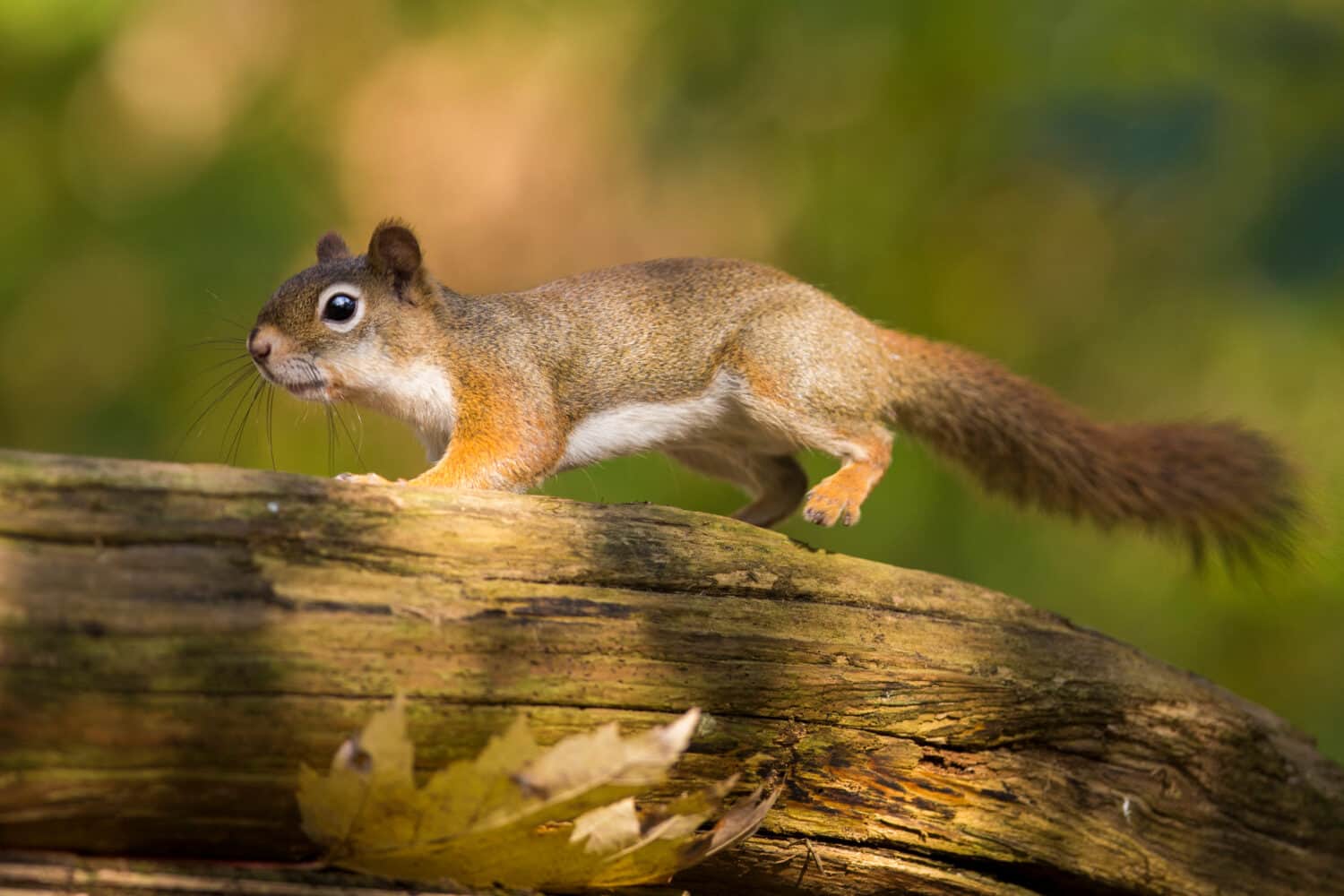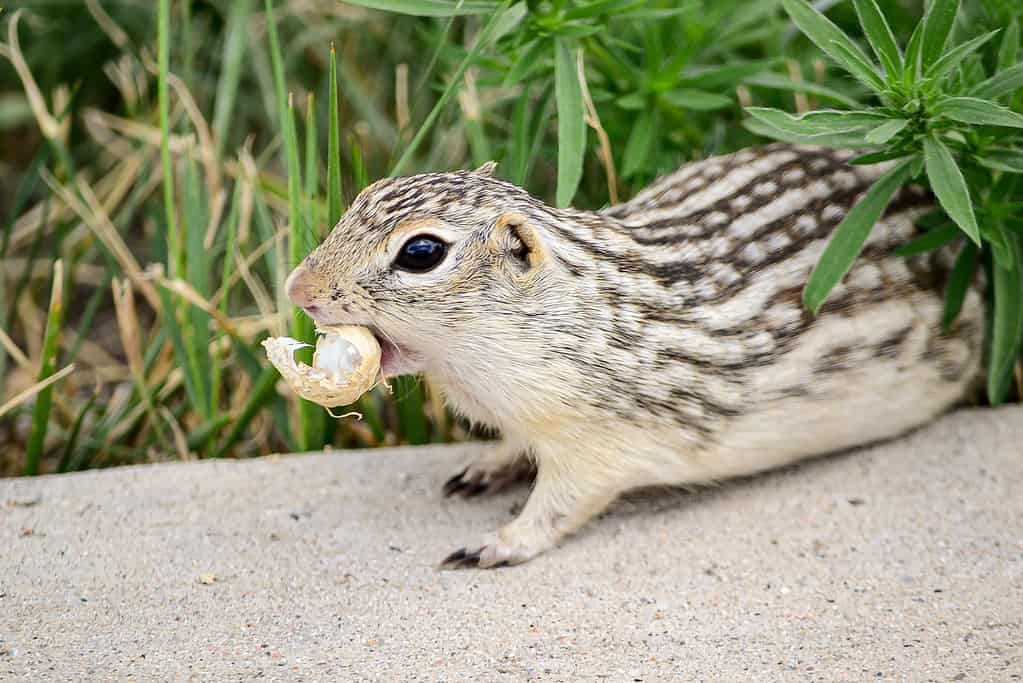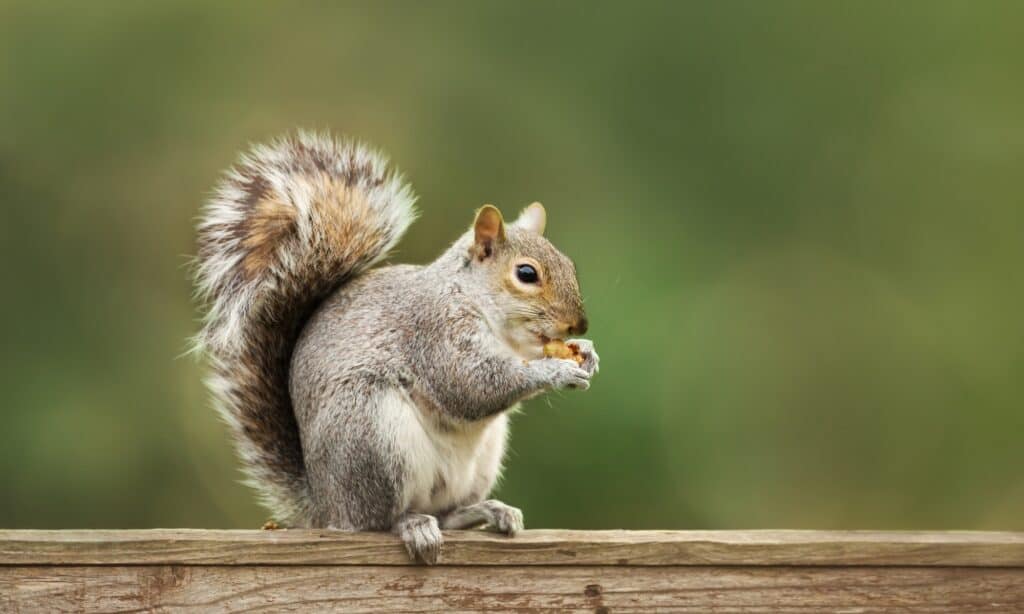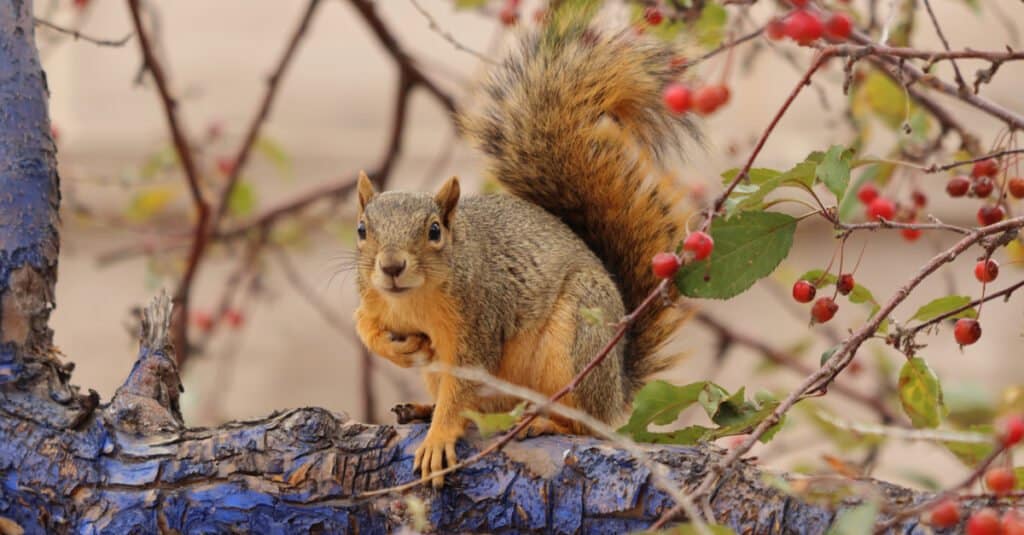While many wild animals are elusive, the same cannot be said for squirrels. Squirrels are seemingly everywhere. In fact, the animals are so widespread that there are squirrels in every state in the United States except for Hawaii. In total, there are over 65 species of squirrels in the country, which fall into three categories: Ground squirrels, tree squirrels, and flying squirrels.
With so many types of squirrels, it’s no surprise that all three categories of squirrels can be found across the Midwest, including Ohio. Ohio has five species of squirrels, including one ground squirrel, three tree squirrels, and one flying squirrel. But which is the most common squirrel in Ohio? It may surprise you! Read on to learn about the different types of squirrels in the Buckeye State—and find out which one tops the population charts.
1. American Red Squirrel

American red squirrels, also known as pine squirrels, are called “boomers” in the Appalachian mountains.
©Mircea Costina/Shutterstock.com
The least common squirrel in Ohio, American red squirrels (Tamiasciurus hudsonicus) prefer conifer trees, particularly spruce. While they will live in suburbia, they tend to congregate in coniferous forests where these trees are prevalent. Red squirrels are a rusty, greyish, or red color with a white belly and a white ring around their eyes. These petite tree squirrels measure 11-13 inches in length, including their tails.
Unlike other squirrels, red squirrels do not bury their food. Instead, they cache food in large middens that they create in the center of groups of trees. These middens are large mounds of spruce cones, that can measure several feet wide and tall. It’s estimated that red squirrels eat 50-150 of these cones per day, so their stashes have to be large.
2. Thirteen-Lined Ground Squirrel

On average, thirteen-lined ground squirrels weigh 110-270 grams, while chipmunks only weigh up to 150 grams.
©BT Images/Shutterstock.com
The thirteen-lined ground squirrel (Spermophilus tridecemlineatus) is often overlooked because it doesn’t live in trees like other squirrels. Instead of nesting in trees, this squirrel digs extensive burrows and lives underground. Found primarily in western Ohio, ground squirrels live in open prairies, cemeteries, or golf courses.
Ohio’s ground squirrels are small, measuring just 4-6 inches long, with 3-4 inch tails—not much bigger than an eastern chipmunk. As their name describes, they have 13 cream-colored stripes running down the brown fur on their backs. These stripes alternate between solid lines and lines of dash-like spots. Unlike a chipmunk, the ground squirrel’s stripes extend up onto its head, while a chipmunk’s does not.
3. Eastern Gray Squirrel

Eastern gray squirrels are omnivores, and eat acorns, seeds, nuts, and fruit, as well as eggs and insects.
©iStock.com/Dgwildlife
A common sight in yards and at birdfeeders across Ohio, the eastern gray squirrel (Sciurus carolinensis) is highly adaptable. These tree squirrels are comfortable in a variety of habitats including forests, suburban, and urban areas. A medium-sized squirrel, the eastern gray is around 8-10 inches long, with an additional 8-10 inches of bushy tail. While most of these squirrels are gray in color, they can also be black or white. Black squirrels are sometimes mistaken for a different species, but are in fact eastern gray squirrels with a melanistic gene. This means they have more melanin, making them a darker color.
White coloration in eastern gray squirrels could mean they are albino (lacking all pigment), or they could be leucistic. Leucism (like melanism) is a genetic anomaly that reduces the pigment in the squirrel’s fur. Squirrels with leucism do not have red eyes like those with albinism and often have gray fur on their heads. While there is no harm in leucism, it does make it more difficult for these squirrels to hide from predators.
4. Fox Squirrel

Although they are tree squirrels, the fox squirrel spends much of its time foraging for food on the ground.
©Vaclav Matous/Shutterstock.com
Fox squirrels surpass the rest of Ohio’s tree squirrels in size substantially. In fact, the fox squirrel (Sciurus niger) is the largest tree squirrel in all of North America. These big squirrels have bodies measuring 18-29 inches long, with tails that add an additional 8-13 inches. They can weigh up to 3 pounds, which is double the weight of the 1.5-pound gray squirrels. This size difference is a big differentiator between gray and fox squirrels; while both are grayish in color, the fox squirrel has a reddish tail and cheeks. While gray squirrels have white stomachs, fox squirrel’s stomachs range in color from cream to orange.
Like gray squirrels, fox squirrels are common in suburban and urban areas. Not native to Ohio, the fox squirrels moved in when deforestation became prevalent. Their big leafy nests are easily visible in trees. However, they will also den inside hollow trees, or in attics or garages. Fox squirrels will have multiple nests so that they can move their babies to a new location if necessary. Despite how many of these squirrels are seen in neighborhoods and forests, the fox squirrel is not the most common squirrel in Ohio.
5. Southern Flying Squirrel

Flying squirrels, the most common squirrel in Ohio, can glide 150-500 feet.
©Tony Campbell/Shutterstock.com
Southern flying squirrels (Glaucomys volans)may be Ohio’s best-kept secret. These nocturnal squirrels rarely come out during the day, so many people never see them or even realize they are around. But just because you can’t see them doesn’t mean they aren’t there: flying squirrels are actually the most common squirrel in Ohio.
Despite their name, flying squirrels cannot actually fly. However, they have a loose flap of skin that extends from their wrists to ankles called a gliding membrane. When the squirrel outstretches its limbs, this membrane allows them to glide when they jump from tree to tree.
Southern flying squirrels have a grayish-brown back with white stomachs and large eyes. These big eyes help them see in the dark, allowing them to navigate at night easily. Smaller than its tree-squirrel counterparts, flying squirrels measure about 8-10 inches, including their tails which are 3-4 inches long and flat. The flat tails act as rudders when the squirrel glides, allowing them to steer them in the correct direction.
Another reason people rarely see flying squirrels is that they are cavity nesters, living inside trees or abandoned birdhouses. They are social squirrels and will den together in winter, sometimes gathering in groups of up to 25 animals.
Since flying squirrels are so elusive, it is quite a treat to see one. If you identify a flying squirrel den, you can sometimes lure them out to get a good look at them. The best way to do this is to spread peanut butter around the entrance to the den and set up a trail camera or night-vision motion-activated camera. Once it is fully dark, the squirrels will come out to investigate the delicious-smelling peanut butter, and you can catch them on film.
Summary of Squirrels in Ohio
| Squirrel Name | Scientific Name | Description |
|---|---|---|
| 1. American Red Squirrel | Tamiasciurus hudsonicus | Rusty/red in color with white around the eyes; 11-13 inches long including the bushy tail |
| 2. Thirteen-Lined Ground Squirrel | Spermophilus tridecemlineatus | Frown fur with alternating solid and dashed white stripes from head to tail; 7-10 inches long including the tail |
| 3. Eastern Gray Squirrel | Sciurus carolinensis | Gray in color with a white underbelly; 8-10 inches long with an 8-10 inch bushy tail |
| 4. Fox Squirrel | Sciurus niger | The biggest of Ohio’s squirrels. Grayish red in color with red cheeks and reddish bushy tail and cream to orange-colored underbelly; 18-29 inches long with an 8-13 inch tail |
| 5. Southern Flying Squirrel | Glaucomys volans | The biggest of Ohio’s squirrels. Grayish red in color with red cheeks and tail and cream to orange-colored underbelly; 18-29 inches long with an 8-13 inch tail |
The photo featured at the top of this post is © Agnieszka Bacal/Shutterstock.com
Thank you for reading! Have some feedback for us? Contact the AZ Animals editorial team.







